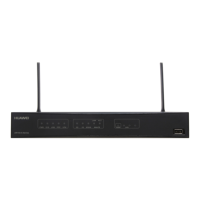N
o.
Data
6 Authentication information, authorization mode, and working directory of the FTP/
TFTP server (optional)
7 IP address of the FTP/TFTP server
8 MAC addresses or ESNs of routers, version files (optional), patch files (optional), and
configuration files
6.3.2 Configuring the DHCP Server
Routers obtain IP addresses and option parameters after the DHCP server is configured.
Context
After a new AR150/200 or an unconfigured AR150/200 is powered on, the Auto-Config process
starts automatically.
When you connect to the console port of an AR150/200 that does not have a startup configuration
file, the system displays "Auto-Config is working. Before configuring the device, stop Auto-
Config. If you perform configurations when Auto-Config is running, the DHCP, routing, DNS,
and VTY configurations will be lost. Do you want to stop Auto-Config? [y/n]:"
l To continue Auto-Config, enter n and press Enter.
l To stop Auto-Config, choose y and press Enter.
CAUTION
If you choose n but still perform configurations through the console port, the DHCP,
routing, DNS, and VTY configurations will be lost.
To stop the Auto-Config process, use either of the following methods:
l Run the undo autoconfig enable command in the system view. You can run the display
autoconfig-status command to check whether the Auto-Config process stops.
l When you log in to the device through the console port, the system displays "Auto-Config
is working. Before configuring the device, stop Auto-Config. If you perform configurations
when Auto-Config is running, the DHCP, routing, DNS, and VTY configurations will be
lost. Do you want to stop Auto-Config? [y/n]:". Enter Y.
Before powering on the Auto-Config-enabled routers, configure the DHCP server and file server;
otherwise, the routers cannot obtain configuration files.
Huawei AR150&200 Series Enterprise Routers
Configuration Guide - Device Management 6 Auto-Config
Issue 02 (2012-03-30) Huawei Proprietary and Confidential
Copyright © Huawei Technologies Co., Ltd.
103

